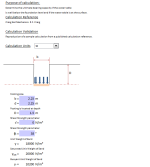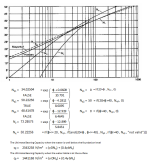Bearing Capacity

Description
Purpose of calculation:
Determine the ultimate bearing capacity if the water table is well below the foundation level and if the water table is at the surface.
Calculation Reference
Craig Soil Mechanics. R.F. Craig
Calculation Validation
Reproduction of a sample calculation from a published calculation reference.
Calculation Reference
Craig's Soil Mechanics
Soil Mechanics
Bearing capacity is the maximum load that a soil can support without experiencing failure or excessive settlement. The bearing capacity of soil is an important consideration in the design of foundations for structures such as buildings, bridges, and retaining walls.
The calculation of bearing capacity following R.F. Craig's Soil Mechanics involves the following steps:
- Determine the soil properties, such as the soil type, unit weight, angle of internal friction, and cohesion.
- Determine the depth of the foundation, the width of the foundation, and the shape of the foundation.
- Determine the ultimate bearing capacity of the soil using one of the following methods: a. Terzaghi's bearing capacity equation, which relates the ultimate bearing capacity to the soil properties and the width and depth of the foundation. b. Meyerhof's bearing capacity equation, which includes correction factors for the shape of the foundation and the effect of the soil cohesion. c. Hansen's bearing capacity equation, which includes correction factors for the shape of the foundation, the effect of the soil cohesion, and the surcharge loads on the foundation.
- Calculate the allowable bearing capacity of the soil by applying a factor of safety to the ultimate bearing capacity, typically ranging from 2.0 to 3.0.
- Determine the required size and shape of the foundation based on the allowable bearing capacity and the design loads.
The analysis of bearing capacity can be further refined by considering other factors, such as the presence of groundwater, the effect of soil stratification, and the effect of soil consolidation. The analysis can also be performed using computer software or spreadsheet programs, which can provide more accurate and efficient results.
Overall, the calculation of bearing capacity following R.F. Craig's Soil Mechanics provides a rigorous and systematic approach to design and construct foundations that can support the required loads and ensure the stability and safety of the structures.
Calculation Preview
Full download access to any calculation is available to users with a paid or awarded subscription (XLC Pro).
Subscriptions are free to contributors to the site, alternatively they can be purchased.
Click here for information on subscriptions.


